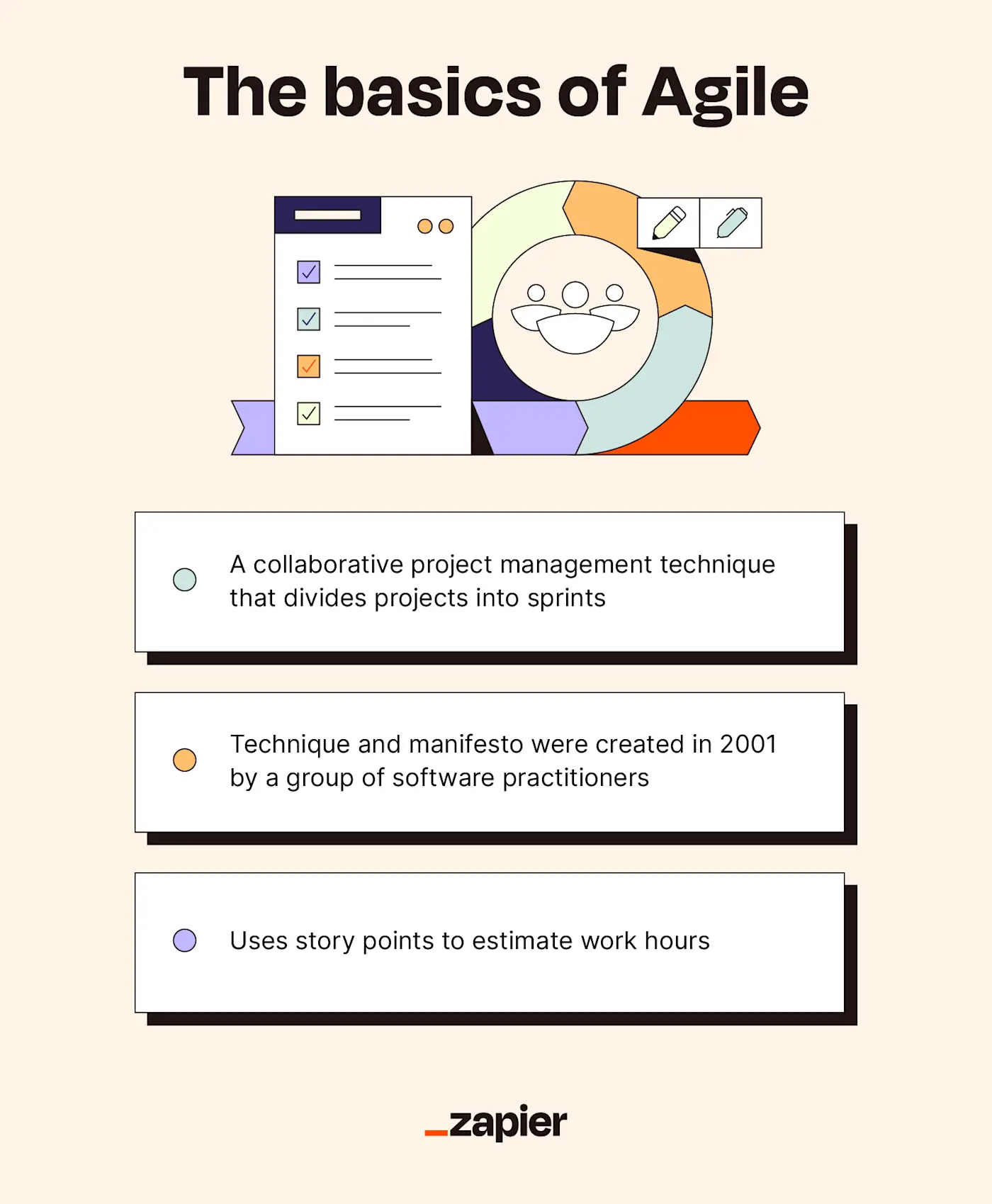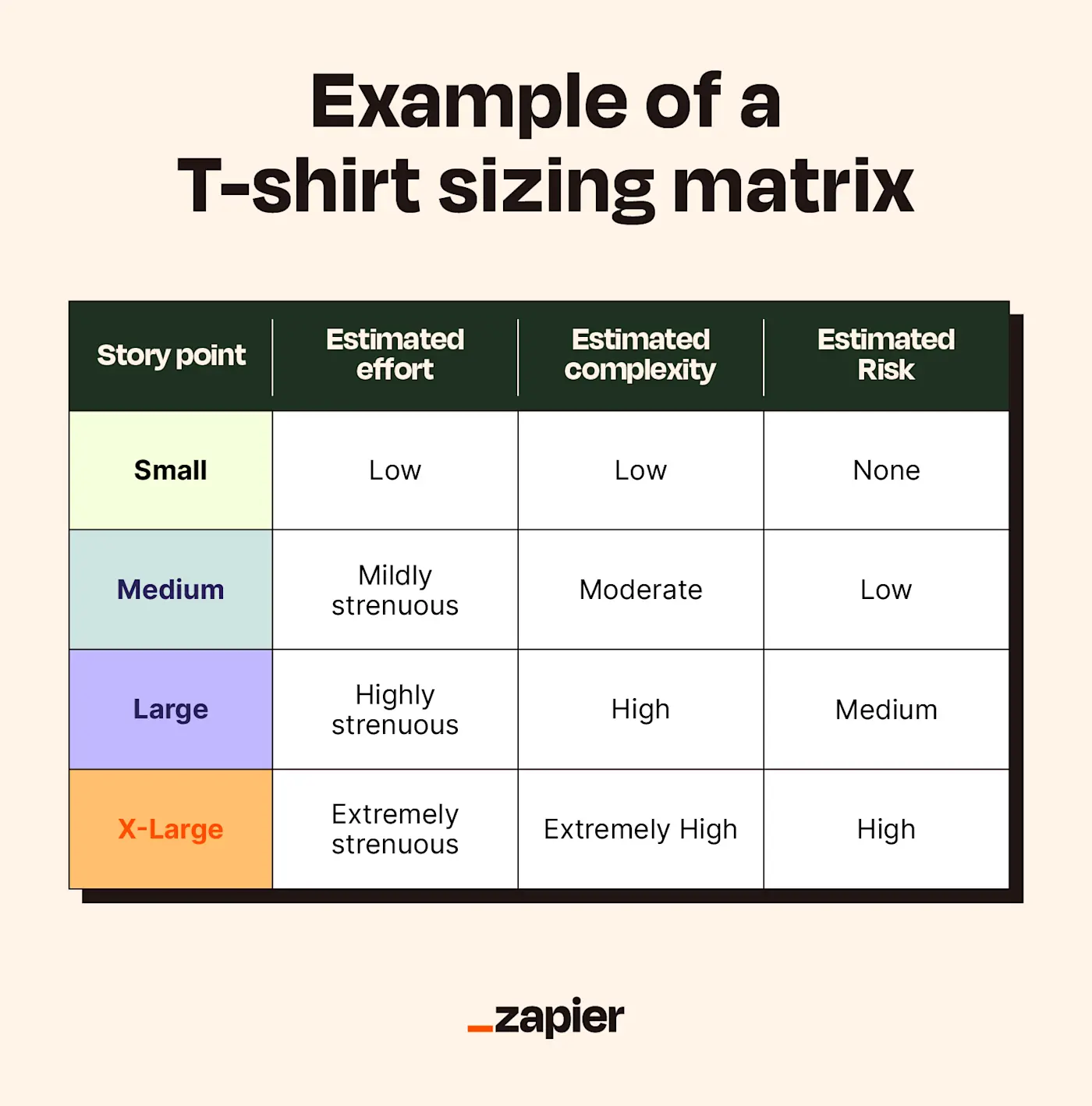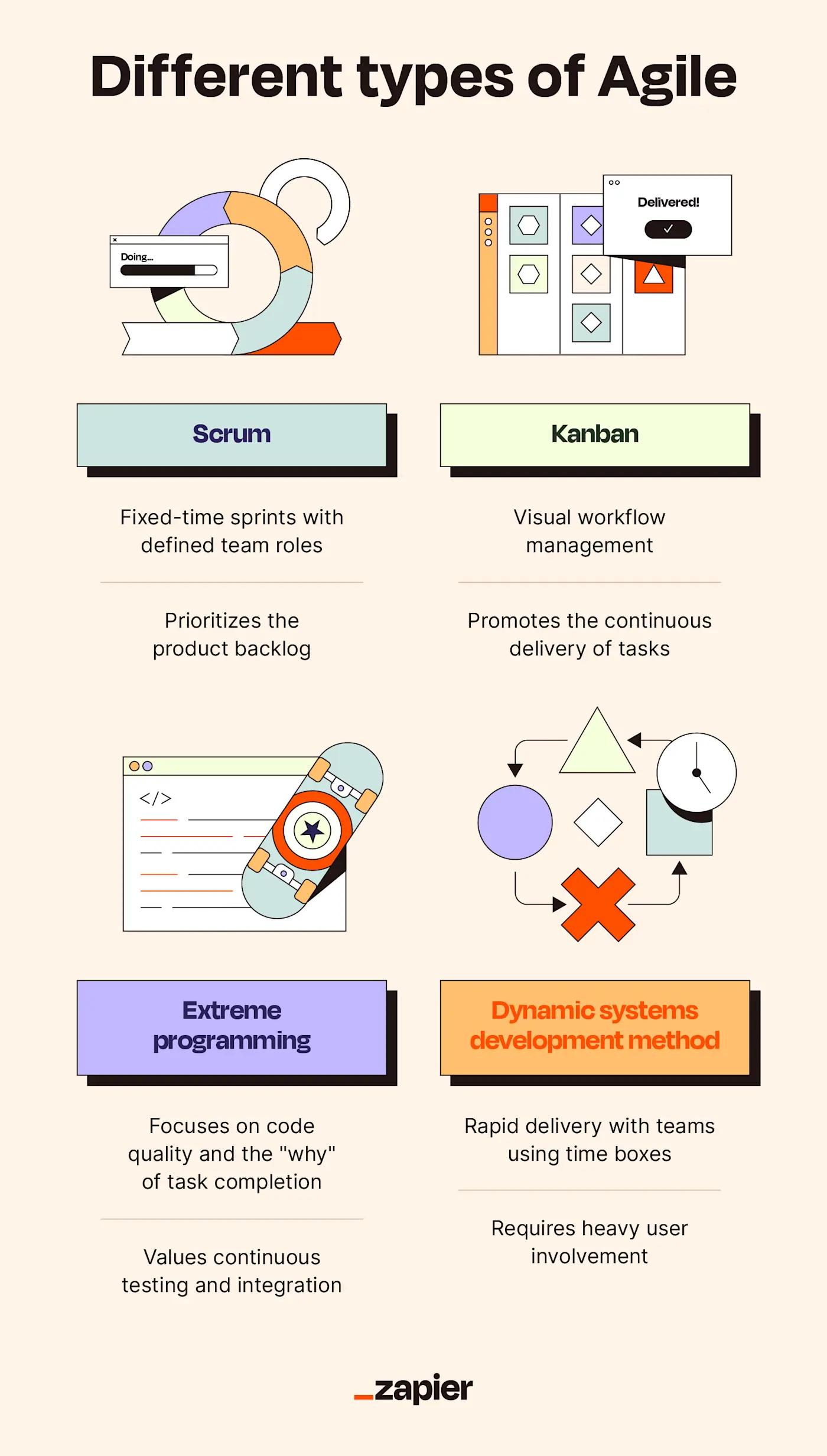I’ve watched enough “Hell’s Kitchen” to say a sous chef at a Michelin star restaurant may be the hardest job on earth. They’re consistently overwhelmed with orders, directing their team on what to cook next, and mentally timing meals to perfection—all while a Gordon Ramsay wannabe head chef screams in their ear.
Whether they realize it or not, all successful sous chefs use a quasi-culinary form of Agile project management: a technique that helps teams dynamically prioritize tasks and get work done efficiently.
I chatted with a few real-life Agile practitioners—and dug deep into Agile documentation—to bring you this complete guide to the Agile methodology, so you can survive your organizational dinner rush.
Table of contents:
What is the Agile methodology?

The Agile methodology is a project management technique that divides projects into dynamic, time-bound phases called sprints. It’s a flexible, collaborative approach that helps teams prioritize tasks and complete work efficiently.
Agile was first created in 2001 by a team of 17 software practitioners. As the legend goes, they descended into a dimly lit cavern and didn’t emerge until they reached a consensus on a new project management technique (or something like that). Folklore aside, the group collaborated to create the Agile Manifesto—the complete guide on rules, principles, and guidelines.
Although this method was created with software development and engineering teams in mind, anyone from customer support agents to kitchen staff can use it to reach their project goals.
The values and principles of Agile
The fateful group of software engineers didn’t just develop the system itself: they also laid out the values and principles of Agile. Here’s the information you’ve been dying to know (since you first learned about it 10 seconds ago).
The 4 values of Agile
There are four key values in the Agile Manifesto:
-
Individuals and interactions over processes and tools: The people (and their skills) matter more than what your college management class taught you.
-
Working software over comprehensive documentation: Delivering a product is more important than saying you can deliver a product—value tangible action over step-by-step documentation.
-
Customer collaboration over contract negotiation: Customers are the driving force of the marketplace, and their thoughts, feelings, and ideas should rise above pre-defined rules.
-
Responding to change over following a plan: As you proceed through your project, be flexible and embrace change when it comes naturally rather than following a rigid project plan.
The 12 principles of Agile
While I’m not totally sure what the difference between a value and a principle is, there are 12 principles in the Agile Manifesto:
-
Our highest priority is to satisfy the customer through the early and continuous delivery of valuable software. Deliver a working product frequently—this shows your customers that you’re making progress and responding to their needs.
-
Welcome changing requirements, even late in development. Agile processes harness change for the customer’s competitive advantage. Embrace change; sometimes it can be the catalyst for something greater.
-
Deliver working software frequently, from a couple of weeks to a couple of months, with a preference for the shorter timescale. As with principle one, delivering small, incremental deliverables is better than one large update in the future.
-
Business people and developers must work together daily throughout the project. Sometimes, it can seem like employees (say, marketers and software engineers) are from two different planets. The more they interact, the more they can share ideas and offer advice from a different perspective.
-
Build projects around motivated individuals. Give them the environment and support they need, and trust them to get the job done. Adopt an effective management style by finding good team members and letting them do their jobs—no one appreciates a micromanager.
-
The most efficient and effective method of conveying information to and within a development team is face-to-face conversation. Written communication can be hard; for example, someone could seem angry over email when maybe they just had a long day. Face-to-face communication makes it easier for everyone to be on the same page.
-
Working software is the primary measure of progress. A product isn’t a product unless it works. Prioritize functionality in your project management.
-
Agile processes promote sustainable development. The sponsors, developers, and users should be able to maintain a constant pace indefinitely. Teams that work 60+ hours a week will face fatigue, burnout, and caffeine-induced hallucinations. Ensure everyone works manageable hours to promote consistent progress.
-
Continuous attention to technical excellence and good design enhances agility. Doing things right the first time helps speed up your processes and progress.
-
Simplicity—the art of maximizing the amount of work not done—is essential. While this 10th principle is not simple (too wordy for my taste), it preaches that simplicity should be the preferred route.
-
The best architectures, requirements, and designs emerge from self-organizing teams. Pick your teams wisely—those who can self-motivate and get work done will be the most effective.
-
At regular intervals, the team reflects on how to become more effective, then tunes and adjusts its behavior accordingly. Host periodic meetings to evaluate progress and see if anyone has room to improve.
Pros and cons of Agile
Agile is a killer project management method—but it’s not without drawbacks. Here are some pros and cons of the strategy.
Pros of Agile
Agile can transform your organization into a productivity powerhouse ready to lay waste to any project that crosses your path. You can benefit from this method in ways like:
-
Enhanced collaboration and productivity: Agile values continuous communication among teams and promotes breaking down silos to share information and boost productivity. Vivian Au, founder of Air Corporate, told me that her team reduced project completion times by 40% after implementing Agile practices.
-
Increased adaptability: Teams may make mistakes, miss deadlines, or stumble upon “happy accidents.” Agile empowers teams to pivot when needed and listen to their customers or end users to determine the best course of action.
-
Improved customer experience: Agile promotes small, incremental updates to show your end users that you’re making progress. This can lead to a final product that meets user needs and shows them that you value your input. As another firsthand testament, Au also said that her team increased client satisfaction scores by 35% after adopting Agile.
-
Boosted team morale: Agile decrees that you should choose resourceful, capable teams, promote work-life balance, and avoid micromanaging. This approach can improve team morale and promote a healthy work culture.
Cons of Agile
While Agile can work in many situations, it may not be right for every project. Here are some drawbacks of the method:
-
Learning curve: Agile is effective, but it can be difficult to pick up—especially for teams that have never used a project management methodology.
-
Team dependency: In the Agile framework, there’s a reliance on capable employees who get their work done. If you have a problem worker or two, they could singlehandedly derail your project or timeline.
-
Change resistance: Not everyone likes or agrees with changing processes—especially if your old method worked just fine. Be wary of stubborn employees.
-
Documentation challenges: While one of the values of Agile is working software over documentation, you need to have some records of how you got from A to B. If your team has challenges with documentation throughout your processes, it could be difficult to replicate your success in future projects.
How to use Agile project management
Now, the moment you’ve all been waiting for: the guide on how to use this mythical Agile.
Set your goals
The first step in adopting an Agile approach is determining what you want to achieve with the technique. Some common goals include:
Narrowing down what’s important before you start will set you off on the right path, and can act as your guiding light as you move forward.
Educate your team (or yourself)
Agile can be confusing—and it’s even more confusing when you realize there are multiple frameworks within Agile you can choose from (more on that later). Before you get started, educate yourself and your team on the ins and outs of Agile: tell them what they can expect, give them resources to peruse, and hold introductory meetings. You may even want to establish a communication plan to ensure you can roll out the strategy effectively.
It’s worth taking a moment to convey the benefits to ensure everyone agrees with the strategy. Harrison Tang, co-founder and CEO of Spokeo, told me:
“I’ve seen firsthand how Agile can transform a team’s workflow and productivity. One of my favorite examples is from our early days. We were working on a major update to our people search engine, and we were struggling to meet the deadline. We decided to switch to an Agile approach, breaking down the work into smaller, manageable chunks. We prioritized the most critical features, and our team worked tirelessly to deliver them. The result? We launched on time, and the update was a huge success.
Another example that comes to mind is our ‘Spokeo Sprints.’ We hold bi-weekly sprints where our teams focus on specific projects or features. It’s amazing to see how much we can accomplish in such a short timeframe. The sense of camaraderie and accomplishment is palpable, and it’s been a huge morale booster for our team. I’m a big believer in Agile, and I think it’s been instrumental in driving our success at Spokeo.”
Establish your Agile foundation

You need to have a deep understanding of what tasks you typically complete and how long it takes to complete them. As you strengthen your knowledge, you’ll want to complete a few activities:
-
Define your scale: You need a way to rank or measure your tasks. Scales—which you can visualize as a matrix—can help you do that. Popular methods include the Fibonacci sequence (0, 1, 2, 3, 5, 8…) or T-shirt sizing (small, medium, large, XL). In all scales, the smaller numbers or figures indicate easier tasks, and vice versa.
-
Estimate story points: Story points are the unit of measurement in Agile that accounts for complexity, risk, and effort when completing tasks. They’re the variables on your chosen scale—e.g., small/medium/large/XL in T-shirt sizing. To illustrate (using T-shirt sizing and cooking terms), your team may decide that serving a pre-made salad to a customer may be a “small” on the scale, while cooking a beef Wellington to order may be an “XL.”
-
Complete planning poker: Planning poker involves holding a meeting and giving every team member some cards with your scale on them. The leader will propose a task, and team members will lay down a card guessing a story point. If there are any discrepancies (like if half your team puts down “medium” and the other half “large”), briefly discuss with the group to make sure everyone is on the same page.
-
Establish your backlog: A product backlog is the central repository for all your Agile efforts. It’s a prioritized list of work items like tasks, features, and requirements, that are necessary to complete a project (keeping in mind that priorities can shift and the order of the backlog will shift along with them). Establishing an effective backlog is one of the final steps when taking off your Agile training wheels and riding down the block.
-
Select the right technology: No matter which Agile framework you choose, you’ll need the right Agile project management software to help you reach your goals. If you aren’t ready for end-to-end software, consider using your existing software to start—like creating a Kanban board on Google Sheets.
Start working in time-bound sprints
When you’re using Agile, you’ll want to divide your work into sprints, or timed work periods. For software developers, this can be a stretch of two to four weeks when the team tries to get as much work done as possible (within reason). For sous chefs, this could be the lunch or dinner hours. Equipped with your scale, story points, and sprint timing, you can assign some tasks from your backlog and hunt for completion.
To put theory into action, let’s say a kitchen is in the midst of a busy, profanity-laced dinner rush. Our star sous chef may get an order for four “XL” tasks and three “small” tasks—say, a handful of bone-in ribeye and a few different salads. Confident in his Agile abilities, he’ll instruct the team to focus on the ribeyes first since they’re the most complex and take the most time. Once they’re almost done, he’ll ask his team to make the salads. Since his timing is impeccable, the order gets completed in tandem, and the steaks and salads are delivered to the happy table.
Monitor and improve
Your very first Agile sprint may make you feel like a dishwasher who was just promoted to head chef out of the blue. Expect to make mistakes, and brace yourself for an inefficient work period that will make you question why you’re learning Agile in the first place. The important thing is to monitor your progress and find ways to improve with every project cycle—before long, you’ll be directing your organizational kitchen in your sleep.
Popular Agile frameworks

Agile isn’t the be-all and end-all of project management techniques; in fact, it’s more like ice cream. You don’t have to get vanilla (the standard Agile framework) every time you go to Baskin-Robbins—you could also get chocolate, strawberry, or (dare I suggest it) swirl. Here are some of the related Agile flavors:
-
Scrum: This method has clearly defined employee roles and a “scrum master” that pushes projects from a backlog into a two-to-four-week sprint, and, finally, delivery.
-
Kanban: Kanban can be used in tandem with Agile to visualize projects through a Kanban board. The board is divided into sections, like ideas, partially done, almost done, and done; teams can create this by hand or with a Kanban tool.
-
Extreme programming (XP): XP is a more technical form of Agile that focuses on the “why” behind task completion and prioritizes simplicity.
-
Dynamic systems development method (DSDM): This is a popular European project management method that focuses on frequent delivery, active user involvement, and empowered teams.
Boost productivity with Agile and Zapier
If you want to reach Michelin star-level heights in project management, you need to add a little extra garnish to your Agile routine—and that calls for automation.
With Zapier, you can connect your Agile software to the rest of your tech stack to create a task-crushing machine. Automatically turn your calendar events, emails, or chat messages into tasks, or send information from your Agile software to the other tools you use. Learn more about how you can automate project management to turn your team into a productivity powerhouse.
Related reading: